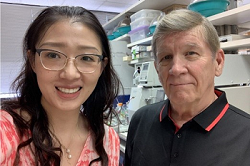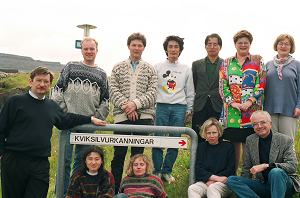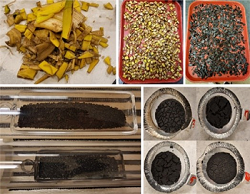Hot Off the Press
E-Factor Stories

Skin Cream May Protect Against Floodwater Contaminants
Texas A&M University scientists led by Tim Phillips, Ph.D., developed a skin cream that may protect people from contaminants in floodwaters, such as benzene, toluene, and xylene. The cream, which forms a barrier between human skin and contaminants, is the culmination of several studies, partially funded by SRP, which have explored materials that can trap toxicants to reduce human exposures.
Toxicologists Discuss PFAS, Air Pollution, and Vulnerable Communities
Scientists, including SRP staff, grant recipients, and trainees who work to identify how chemicals may cause harm gathered Sept. 14 for the annual North Carolina Society of Toxicology (NCSOT) meeting. The meeting provided an opportunity for collaboration to address toxicants and disparities.
Water Contaminants Identified, Addressed in Marginalized Communities
SRP-funded researchers’ recent studies describe reasons for water contamination disparities, identify current private well disparities, and review how community engagement and interventions, like pitcher filters, can help protect marginalized communities.

Scientific Journeys: From the Faroe Islands to PFAS Research
Philippe Grandjean, M.D., D.M.Sc., has forged a decades-long career in environmental health. Buoyed by NIEHS support since 1992, he has examined the biological effects of exposures to chemicals such as mercury, lead, and polychlorinated biphenyls. As an investigator with the NIEHS-funded University of Rhode Island Superfund Research Program (SRP) Center, Grandjean also works with communities in the Faroe Islands, an archipelago between Iceland and Norway, to study how PFAS affect health.
For PFAS-polluted Sites, Forum Highlights Best Research Practices
Representatives across federal agencies shared strategies for characterizing PFAS-polluted sites and hurdles to interpreting data. NIEHS Superfund Research Program (SRP) Health Scientist Adminstrator Heather Henry, Ph.D., co-organized the event.
Extramural Paper of the Month: Emissions from Indoor Flooring Reflect Airborne PCB Levels
Measuring chemical emissions from flooring can predict polychlorinated biphenyl (PCB) concentrations in room air, according to researchers at the University of Iowa SRP Center. The findings could inform targeted remediation strategies for indoor spaces that contain legacy contaminants.
Extramural Paper of the Month: Metal Mixtures Linked with Biological Aging
Exposure to metals may contribute to higher risks of aging-related diseases in Native American communities, according to researchers at the Columbia University SRP Center.
Extramural Paper of the Month: Mobile Air Pollution Monitoring Following an Environmental Disaster
Nontargeted mobile monitoring can complement stationary monitoring during disaster response to better characterize exposures to air pollution, found a team at the Texas A&M University SRP Center. In contrast to traditional stationary screening methods, which target specific chemicals, nontargeted analysis quantifies all chemicals in a sample and uses large chemical databases to identify unknown components.
Extramural Paper of the Month: Dogs and Horses May Be Important Indicators of PFAS Exposure
Companion animals and livestock may provide insight into human exposure to PFAS inside and outside the home, according to a North Carolina State University SRP Center study. The scientists identified elevated levels of PFAS in dogs and horses from Gray's Creek, North Carolina, a neighborhood near a PFAS manufacturing plant.
Extramural Paper of the Month: New Method Generates Airborne Free Radicals for Laboratory Study
SRP-funded researchers at Louisiana State University developed a new approach to improve how environmentally persistent free radicals are generated and studied in the lab. This strategy addresses a deficiency in methods to simulate realistic environmental exposures in animals.
Extramural Paper of the Month: Microbial process for PFAS breakdown uncovered
A study funded by SRP revealed important mechanistic information about how some microbes break down PFAS in the environment. The findings may inspire more cost-effective bioremediation approaches.
News Stories

Burning Banana Peels to Remove Contaminants from Water
Researchers at the Northeastern University SRP Center explored a new method to remove contaminants from water using biochar — a conductive, absorbent material — made from banana peels. This approach could inform large-scale, low-cost treatments in water systems, according to the authors.
New Workflow Improves Data Management and Sharing
A team of scientists funded by the NIEHS SRP published a new workflow to help researchers across disciplines share environmental health data more effectively. The workflow provides a standardized framework for collecting, organizing, and distributing scientific data so that it can be more easily understood and used by other groups.
Research Briefs
Mechanism of Cadmium-Induced Neurotoxicity, Potential Treatment Revealed
A particular class of extracellular vesicles protects against neurotoxicity caused by cadmium exposure, according to a study at the Harvard School of Public Health SRP Center. Extracellular vesicles are small packages of fats, nucleic acids, or proteins that allow cells to communicate with each other and support numerous cellular functions.
High-Temperature Biochar for Arsenic Remediation
Adding biochar produced at a high temperature may be an effective way to immobilize arsenic in sediment, according to researchers partially funded by the SRP. Led by Owen Duckworth, Ph.D., of the University of North Carolina at Chapel Hill SRP Center, the study provided further insight into the conditions that influenced the effectiveness of biochar for soil remediation.
Environmentally Persistent Free Radicals, PAHs Interact to Increase Toxicity of Particulate Mixtures
Toxic air pollutants called environmentally persistent free radicals may react with certain polycyclic aromatic hydrocarbons on the surface of airborne particles to form more toxic chemicals, according to researchers funded by the SRP. The study demonstrated that interactions between components of fine particulate matter mixtures may enhance their overall toxicity.
Hot Publications
Check out our Hot Publications page to see brief summaries of papers that have been featured in the monthly e-Posted Notes newsletter!
to Top



